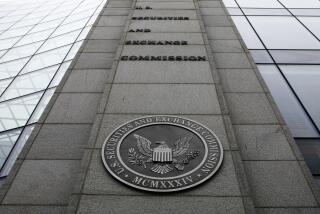Brokerage Executive Joseph R. Hardiman Takes on a New Job : Surveillance of Smaller Stocks on NASD Chief’s Agenda
WASHINGTON — The “pink-sheet” market, one of the last arenas in which stock prices can be manipulated outside of electronic surveillance, would be subject to new public scrutiny under plans being studied by the National Assn. of Securities Dealers.
The NASD, the Washington-based organization that operates the nation’s over-the-counter market, has been urged by the Securities and Exchange Commission to extend its reach to about 13,000 pink-sheet stocks--stocks that are lightly traded and not listed on any exchange.
Pink-sheet stocks get their name from the color of the paper on which a daily price list is printed for use by brokers and traders.
Opening up the pink-sheet market by putting the stock prices on computer screens is one of several far-reaching proposals on the agenda of Joseph R. Hardiman, the new president of the NASD.
“We have to take a much harder look at the conduct of business in that market. And to make sure we’re applying the same types of surveillance standards,” Hardiman said.
Hardiman, a 50-year-old lawyer and brokerage executive from Alex. Brown & Sons Inc. of Baltimore, succeeded Gordon S. Macklin, who spent 17 years as president of the NASD. Macklin joined Hambrecht & Quist Inc., a San Francisco brokerage.
Items on the Agenda
Although Hardiman’s salary as NASD president is not public, he acknowledged that he took a pay cut in his new job.
His total compensation at Alex. Brown in 1986 was $725,000. The NASD currently has a budget of $130 million and employs 1,700 people.
The Hardiman agenda also calls for:
- A top-to-bottom review of the NASD’s role as a regulator of 6,700 NASD-affiliated brokerage firms and the over-the-counter market called NASDAQ, or National Assn. of Securities Dealers Automated Quotations.
- A sweeping study of the NASD’s present electronic surveillance system, with special emphasis on detecting illegal insider trading.
- Computerization of the multibillion-dollar primary and secondary markets in private placements. These are debt or equity issues of corporations that are sold to wealthy individuals or institutional investors.
- The forging of new international links with foreign companies, foreign stock markets and new electronic systems allowing for trades to be executed by computers.
- The development of a new and vastly expanded arbitration system to settle disputes between customers and brokerage firms, as required by recent court decisions and SEC requests.
The Hardiman agenda, a blueprint for a major expansion of the power of the NASD, affects the organization’s two main activities: regulation of members’ activities and operation of the NASDAQ markets.
Hardiman said the NASD was taking on the pink-sheet project at the urging of the SEC.
SEC Commissioner Joseph A. Grundfest said the commission suggested that the NASD move into the pink-sheet market because of the lack of trading information available on those stocks. “It is just very difficult for the commission to monitor what is going on in the pink-sheet market,” he said.
In the past, the SEC had found individual cases of fraud and abuse in pink-sheet stocks, Grundfest said. In one of the deceptive practices, called a “daisy chain,” dealers bump up the price of a stock by swinging shares back and forth between buyers and sellers.
Tracking trading in pink-sheet stocks on computers would tend to discourage many of these abuses, Grundfest said.
A wide variety of companies are listed in the pink sheets. They include young firms that have recently issued stock, firms that are too small to qualify for the regular exchanges, older firms whose fortunes have waned and well-to-do companies whose stock rarely trades because most shares are held by family members.
Beyond the pink-sheet stocks, an overall review of NASD’s electronic surveillance system is high on Hardiman’s agenda.
NASD, along with the New York Stock Exchange and the American Stock Exchange, have systems that set off warnings when a stock trades beyond its normal parameters of price or volume. Those alerts are then investigated.
Question Lingers
But the shadow of the Ivan F. Boesky insider trading scandals hangs heavily over all the exchanges and has raised questions about the efficiency of current surveillance systems.
Hardiman said he had asked: “Are we applying the most sophisticated computer techniques to our surveillance of NASDAQ markets?”
The answer, he said, will come from two sources. One is the task force he appointed in April, when he was chairman of the NASD board of governors. The task force has been charged with a top-to-bottom review of NASD’s role as a regulator of the 6,700 brokerage firms that belong to NASD. The task force is expected to deal with policy issues involving surveillance.
The second answer will come from a computer consultant whom NASD plans to hire soon to determine if there are technological ways to improve the system.
Even so, Hardiman said, he realizes that no matter how good a surveillance system becomes, it may not deter insider trading.
“No matter how sophisticated your surveillance systems are . . . if a person is bent on perpetrating a fraud . . . it’s going to be impossible to develop any absolutely foolproof surveillance technique to prevent insider trading or market manipulation,” Hardiman said.
If the regulators can’t stop the fraud, the next best thing is to be able to detect it and then apply severe penalties, Hardiman said. “I happen to believe that heavy penalties are the most effective way to discourage this activity,” he said.
Heavier penalties are being levied on NASD members who violate the organization’s rules and are subject to disciplinary proceedings by local business conduct committees, Hardiman noted.
“There is a toughening of the attitude at the district business conduct committee level,” Hardiman said. “The penalties have become significantly more severe than they were five years ago. The fines are larger. The willingness to suspend or expel (members) is much more prevalent.”
Capability Questioned
Hardiman said he also hopes to use computers in the rapidly growing primary and secondary markets for private placements--corporate debt or equity securities that are unregistered and are sold to wealthy investors and to institutional investors. He said he is being encouraged to do so by major securities firms.
“The participants in that market, including the investors, would like to have access to that information. . . . There is a very strong desire among the buyers of this type of paper to have the liquidity,” he said.
Dorothy J. Dotson, managing director and head of private placements for Prudential-Bache Securities, estimated that new issues in the private placement market in 1986 totaled $121 billion, while securities traded in the secondary market totaled $10 billion to $12 billion.
The amount of foreign securities sold in this country in 1986 reached $15 billion, she said.
The emphasis in private placements is on long-term investment rather than resale, and purchasers must declare their intent to hold the issues. Dotson questioned whether an electronic market could deal with the paper work and other SEC requirements.
Hardiman said the NASD plan would include a central depository and clearinghouse to handle the paper work.
One of the key challenges facing Hardiman involves the arbitration of complaints brought by customers against brokers. The NASD has seen its cases rise rapidly, from 422 in 1981 to 1,108 in 1984 to 1,587 in 1986.
NASD anticipates a total of 2,400 cases this year, said Deborah Masucci, arbitration director. She said 78% of the cases are customer related, while the remainder involve people within the industry.
NASD is under pressure to expand its arbitration staff and facilities to cope with the effects of a Supreme Court decision that will steer disputes between brokerage houses and their customers to arbitration panels. Previously, the customer could choose either to file suit or use arbitration.
Will Take Hard Look
The SEC, which has been reviewing arbitration needs, recommended changes in the selection of arbitrators and in arbitration procedures, some of which could make the cases resemble courtroom trials.
Hardiman said the NASD would take a hard look at its procedures and at the SEC recommendations. But he said he was concerned that if the NASD was forced to adopt many of the procedures used in court, the arbitrations would be subject to delays and become more costly. At present, many customers are able to take part in arbitration without hiring lawyers.
Masucci said the arbitration division already has seen cases that might normally last less than a day are being stretched to two or three because lawyers know they have no legal recourse and must live with the panel’s decision.
More to Read
Inside the business of entertainment
The Wide Shot brings you news, analysis and insights on everything from streaming wars to production — and what it all means for the future.
You may occasionally receive promotional content from the Los Angeles Times.










